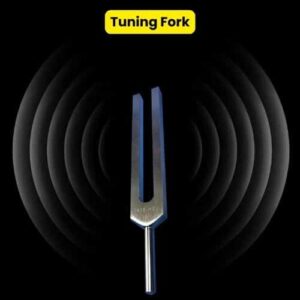Simple Harmonic Motion examples in daily life
Here are the top 7 real-life examples of Simple Harmonic Motion In Physics & Everyday Life.
-
Swinging pendulum clocks.
-
The motion of a child on a swing.
-
Oscillation of a rocking chair.
-
Vibrating guitar strings.
-
Motion of metronome
-
Vibrations of a tuning fork.
-
Car Suspension
It’s important to note that achieving perfect SHM in a real-world car is challenging due to the presence of numerous factors that affect its behavior. Some of the above examples deviate from SHM due to factors like friction, damping, non-linear forces, external influences, and design considerations.
Simple harmonic motion (SHM) is a type of oscillation that is characterized by periodic and repetitive motion. Here, we will explore 7 examples of simple harmonic motion, examples that you might encounter in your day-to-day life.
But before you read any further, it might be a good idea to understand what is simple harmonic motion In Physics briefly. It will help you to understand the examples better. If you are already familiar with the concept, you can skip it by clicking on the link below.
What is simple harmonic motion in physics?
Simple harmonic motion (SHM) is a type of periodic motion in which an object oscillates back and forth around a stable equilibrium position. It occurs when there is a restoring force acting on the object that is directly proportional to its displacement from the equilibrium.
In simple harmonic motion, the object moves with a sinusoidal pattern, with its displacement following a sine or cosine function over time. The motion is characterized by a few key properties:
-
Period: The time taken for one complete cycle of motion, from one extreme position to the next and back again. It represents the time for the object to repeat its motion.
-
Amplitude: The maximum displacement of the object from its equilibrium position. It determines the range of motion or how far the object moves from the equilibrium.
-
Frequency: The number of complete cycles or oscillations per unit of time. It is the reciprocal of the period and represents how quickly the object oscillates.
-
Phase: The position of the object within its cycle of motion at a given point in time. It describes where the object is within the oscillatory cycle.
Examples of simple harmonic motion include pendulums, vibrating springs, swinging objects, and oscillating objects like tuning forks.
Simple harmonic motion is a fundamental concept in physics and has applications in various fields, including mechanics, waves, and oscillations. It provides a useful model for understanding and analyzing the behavior of systems that undergo periodic oscillations.
Formula
The equation that describes the displacement of an object undergoing simple harmonic motion as a function of time is:
x(t) = A * cos(ωt + φ)
Where:
-
x(t) represents the displacement of the object at time t,
-
A is the amplitude of the motion (maximum displacement),
-
ω is the angular frequency of the motion (related to the frequency f by ω = 2πf),
-
t is the time,
-
φ is the phase constant, which determines the initial position of the object within its cycle.
Now let’s dive into the 7 examples of simple harmonic motion in real life.
(SHM) Simple Harmonic Motion Examples In Physics & Daily Life Explained
I am sure that the concept of simple harmonic motion is clear to you now. If not, you can comment below. Let us now move on to 7 examples of simple harmonic motion in physics & in real life.
-
Swinging pendulum clocks

In an idealized scenario, where there is no air resistance or friction, a pendulum swinging back and forth exhibits SHM.The motion of a swinging pendulum follows the principles of SHM because it oscillates around a stable equilibrium position and experiences a restoring force that is directly proportional to its displacement from the equilibrium. As the pendulum swings to one side, it experiences a restoring force (gravity) that pulls it back toward the center. When it reaches the center, it has its maximum potential energy, and as it swings back to the other side, the potential energy is converted into kinetic energy.
In practice, real pendulums are subject to various non-idealities such as air resistance, friction at the pivot point, and the effects of damping. These factors can cause deviations from the ideal SHM. However, in well-designed pendulum clocks, efforts are made to minimize these influences and approximate simple harmonic motion as closely as possible.
-
The motion of a child on a swing

The motion of a child on a swing can be approximated as simple harmonic motion (SHM) under certain conditions. However, it is important to note that it is not a perfect example of SHM due to several factors that affect the swinging motion.As the child swings back and forth, the swing motion resembles that of a pendulum. When the child reaches the highest points of the swing, they experience maximum potential energy, which is then converted into maximum kinetic energy at the lowest points of the swing.
However, real-life swings are subject to various non-idealities, such as air resistance, friction at the pivot points, and the child’s movements affecting the swinging motion. These factors can cause deviations from the ideal SHM. Additionally, the child’s actions, like actively pumping their legs or changing their body position, can introduce additional forces and alter the motion from pure SHM.
Therefore, while the motion of a child on a swing may closely resemble simple harmonic motion, it is not a perfect example due to the presence of external forces and deviations from ideal conditions.
-
Oscillation of a rocking chair

A rocking chair oscillates back and forth around its equilibrium position as it rocks on its curved runners. As it rocks in one direction, it experiences a restoring force that brings it back toward the equilibrium position. The motion is periodic, with the rocking chair passing through the equilibrium position multiple times.Friction can introduce damping effects, causing the oscillations to gradually decrease over time. Additionally, external forces or disturbances can affect the rocking motion and make it more complex.
-
Vibrating guitar strings

Vibrating guitar strings are a classic example of simple harmonic motion (SHM). When a guitar string is plucked or strummed, it vibrates back and forth, producing sound through the principles of SHM. The string oscillates back and forth around the equilibrium position, creating a periodic vibration.The motion of the vibrating guitar string is approximately sinusoidal, meaning its displacement follows a sine or cosine function with respect to time. The frequency of the vibration determines the pitch of the sound produced, while the amplitude relates to the volume.
-
Motion of metronome

A metronome typically consists of a pendulum-like mechanism that swings back and forth to keep a steady beat and assist musicians in maintaining a consistent tempo.
In an idealized scenario, where there is negligible friction and air resistance, a metronome pendulum can approximate SHM. As the metronome swings from one side to the other, it experiences a restoring force (usually provided by a spring or gravity) that brings it back toward the center or equilibrium position.The motion of the metronome pendulum is periodic and exhibits characteristics of SHM. It oscillates around the equilibrium position with a constant period and experiences maximum potential energy at the extreme points of the swing, which is converted into maximum kinetic energy at the center of the swing.
-
Vibrations of a tuning fork

A tuning fork is a slender, metal instrument that produces a specific musical tone when struck or set into vibration.When a tuning fork is struck, it begins to vibrate back and forth. The tines of the tuning fork oscillate around their equilibrium position, experiencing a restoring force that brings them back toward the center. The motion of the tuning fork follows the principles of SHM, with the tines oscillating at a specific frequency and producing a characteristic sound.
-
Car Suspension

A car’s suspension typically includes springs that support the weight of the vehicle and provide a smoother ride by absorbing shocks from bumps and uneven surfaces. When the car encounters an uneven surface, the springs compress and expand to help maintain stability and cushion the impact.
In this system, the springs undergo oscillatory motion that closely resembles SHM. As the car moves over a bump, the springs compress, storing potential energy. This potential energy is then converted into kinetic energy as the springs expand, pushing the car back toward its equilibrium position.
References
- Geeks For Geeks: Simple Harmonic Motion
The article titled “Simple Harmonic Motion” on GeeksforGeeks discusses the concept of simple harmonic motion (SHM) in physics. It provides an overview of SHM, including its definition, characteristics, equations, and examples.

